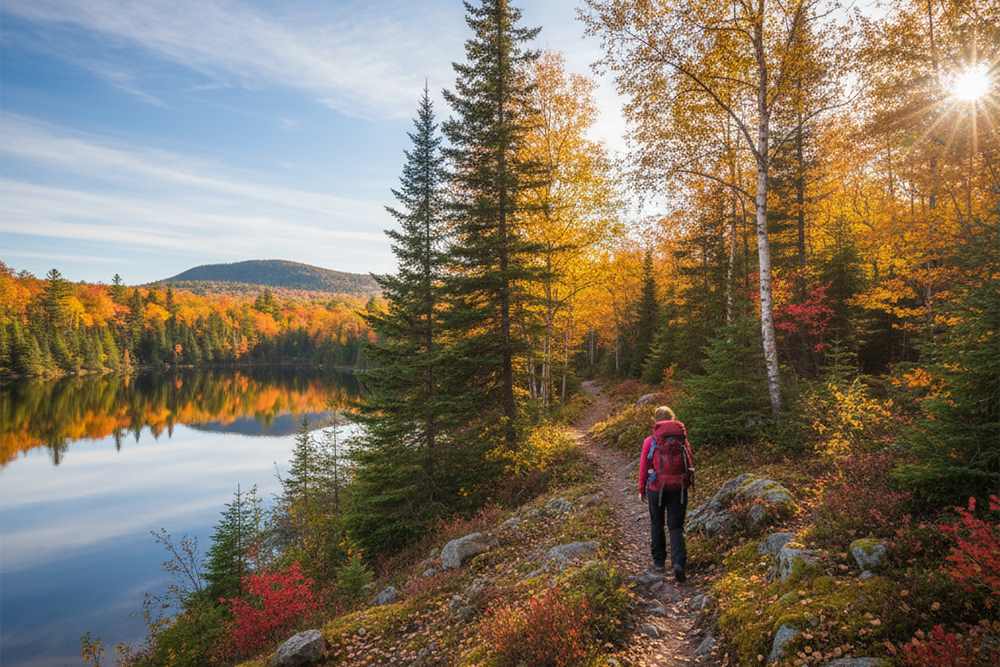Northern Ontario is home to some of the most breathtaking landscapes in Canada—rugged wilderness, endless forests, pristine lakes, and trails that stretch for miles. For outdoor enthusiasts to do a long hike, this region offers an unparalleled opportunity to experience the natural beauty of the North through extended treks. But to fully enjoy and stay safe on these adventures, proper preparation is essential.
Whether you’re planning your first multi-day hike or are an experienced trekker, this guide will cover everything you need to know about hiking preparation, Ontario style. From understanding the terrain to packing essentials and focusing on safety, we’ll help you get ready for the unforgettable long hikes Canada is famous for.
Why Hiking Preparation Matters in Ontario
Ontario’s northern wilderness is vast and unpredictable. While the beauty of remote trails and hidden lakes is unmatched, these same conditions can become dangerous without proper planning. Weather changes quickly, distances can be deceiving, and wildlife encounters are always possible.
Good hiking preparation in Ontario ensures that you’re not just packing the right gear but also developing the right mindset. Preparation reduces risks, increases comfort, and allows you to focus on the joys of the journey rather than potential problems.
Research Your Trail Thoroughly
The first step in preparing for a hike is knowing your trail. Northern Ontario offers a wide range of hiking experiences—from the rugged Lake Superior Coastal Trail to the forested paths of Temagami. Each trail varies in difficulty, distance, and conditions.
Here’s what to look into before heading out:
-
Distance and Duration: How many days will your hike take?
-
Terrain: Expect rocky paths, muddy sections, or steep inclines.
-
Water Sources: Know where you can refill bottles safely.
-
Camping Rules: Some parks allow backcountry camping, while others have designated sites.
When planning long hikes in Canada, remember that conditions in Northern Ontario can be more challenging than expected. What looks like a 10-kilometre trail on paper can feel much longer in the rugged wilderness.
Hiking Gear Tips: Essentials for Success
Packing the right equipment can mean the difference between a memorable hike and a miserable one. Here are some critical hiking gear tips to guide your packing:
-
Backpack: Choose a pack with proper support and space for multi-day hikes.
-
Footwear: Invest in quality hiking boots that provide ankle support and are broken in before your trip.
-
Navigation Tools: Carry a map, compass, and GPS device or app.
-
Clothing: Layered clothing is best—wicking base layers, insulating mid-layers, and waterproof outer shells.
-
Sleeping Gear: A lightweight tent, a sleeping bag rated for cool nights, and a sleeping pad.
-
Cooking Supplies: Portable stove, fuel, and lightweight cookware.
-
First Aid Kit: Tailor it with blister care, bandages, and any personal medications.
-
Lighting: A headlamp with spare batteries.
One of the most overlooked hiking gear tips is testing everything before your hike. Walk with a loaded backpack, try on your boots, and practice setting up your tent. Familiarity prevents surprises when you’re deep in the backcountry.
Nutrition and Hydration
Food and water planning is a crucial part of hiking preparation in Ontario. On long hikes, your body burns far more calories than usual.
-
Water: Bring enough to start and carry a filtration system or purification tablets. Lakes and rivers are plentiful in Northern Ontario, but untreated water isn’t safe to drink.
-
Food: Pack lightweight, calorie-dense items like dehydrated meals, trail mix, nut butters, and energy bars.
-
Meal Planning: Organize meals per day in labelled bags to stay efficient and avoid overpacking.
Hydration is especially important in the summer months. Plan refill points and always carry more water than you think you’ll need.
Outdoor Safety Ontario: Staying Protected
Northern Ontario’s beauty comes with unique challenges. Prioritizing outdoor safety in Ontario ensures that your adventure is memorable for the right reasons.
-
Weather: Conditions can shift quickly, from sunshine to storms. Always check the forecast and pack rain gear.
-
Wildlife: Encounters with moose, bears, or wolves are possible. Carry bear spray, store food securely, and know how to react.
-
Insects: Mosquitoes and blackflies can be intense—bring insect repellent and consider netting for your face.
-
Emergency Plans: Share your itinerary with someone at home. Carry a satellite phone or personal locator beacon in remote areas.
Practicing outdoor safety in Ontario is not just about self-protection—it’s also about respecting the environment. Follow Leave No Trace principles to preserve the wilderness for future hikers.
Physical Conditioning Before the Hike
Hiking long distances over multiple days is physically demanding. Preparing your body in advance is an important part of hiking preparation in Ontario.
-
Cardio Training: Running, cycling, or stair climbing to build endurance.
-
Strength Training: Focus on legs, core, and shoulders to handle backpack weight.
-
Practice Hikes: Start with shorter hikes and gradually increase difficulty while carrying your gear.
Building stamina ahead of time ensures you can fully enjoy your hike without excessive fatigue.
Planning for Campsites
On multi-day hikes, camping is part of the experience. Research campsite availability and book permits in advance if required. In popular parks, designated backcountry sites fill up quickly during peak season.
When camping in remote areas, follow backcountry etiquette:
-
Set up at least 60 metres from water sources.
-
Store food away from tents.
-
Minimize campfire impact or use stoves instead.
A successful camp setup is part of efficient small-scale hiking preparation for Ontario trips.
The Mental Side of Hiking
Long treks can be mentally challenging. Fatigue, insects, or bad weather can test even the most prepared hiker. Developing resilience and a positive mindset are just as important as packing gear.
Remind yourself of why you’re hiking—to disconnect, explore, and challenge yourself. Celebrate small milestones, and embrace the quiet moments of solitude that make long hikes in Canada such a unique experience.
Seasonal Considerations
Northern Ontario hiking conditions vary drastically by season:
-
Spring: Trails may be muddy, and insects are at their peak.
-
Summer: Warm weather but high insect activity.
-
Fall: Cooler, less buggy, with spectacular foliage.
-
Winter: Specialized gear and expertise required—best left to advanced trekkers.
Align your hiking preparation Ontario checklist with seasonal challenges to ensure comfort and safety.
Conclusion
Preparing for a long hike in Northern Ontario requires careful planning, the right equipment, and a strong focus on safety. From researching your trail and perfecting your gear setup to prioritizing nutrition, fitness, and mental resilience, every step of preparation enhances the experience.
With proper hiking preparation in Ontario, your journey through the vast wilderness of Northern Ontario will be more than just a physical trek—it will be a chance to immerse yourself in the breathtaking natural beauty of the Canadian outdoors.
Whether you’re tackling a weekend adventure or embarking on long hikes across Canada’s rugged landscapes, planning is the key to a safe, rewarding, and unforgettable experience.
FAQ’s
Q1. What should I bring on a hiking trip in Ontario?
A: Pack essentials like sturdy boots, layered clothing, maps, a compass or GPS, a tent, a sleeping bag, cooking gear, a first aid kit, water purification, food, insect repellent, and bear spray for safety.
Q2. How can I stay safe on long trails?
A: Prioritize outdoor safety in Ontario by sharing your itinerary, carrying navigation tools, packing weather-appropriate clothing, storing food securely, using insect protection, and keeping emergency communication devices like a satellite phone.


